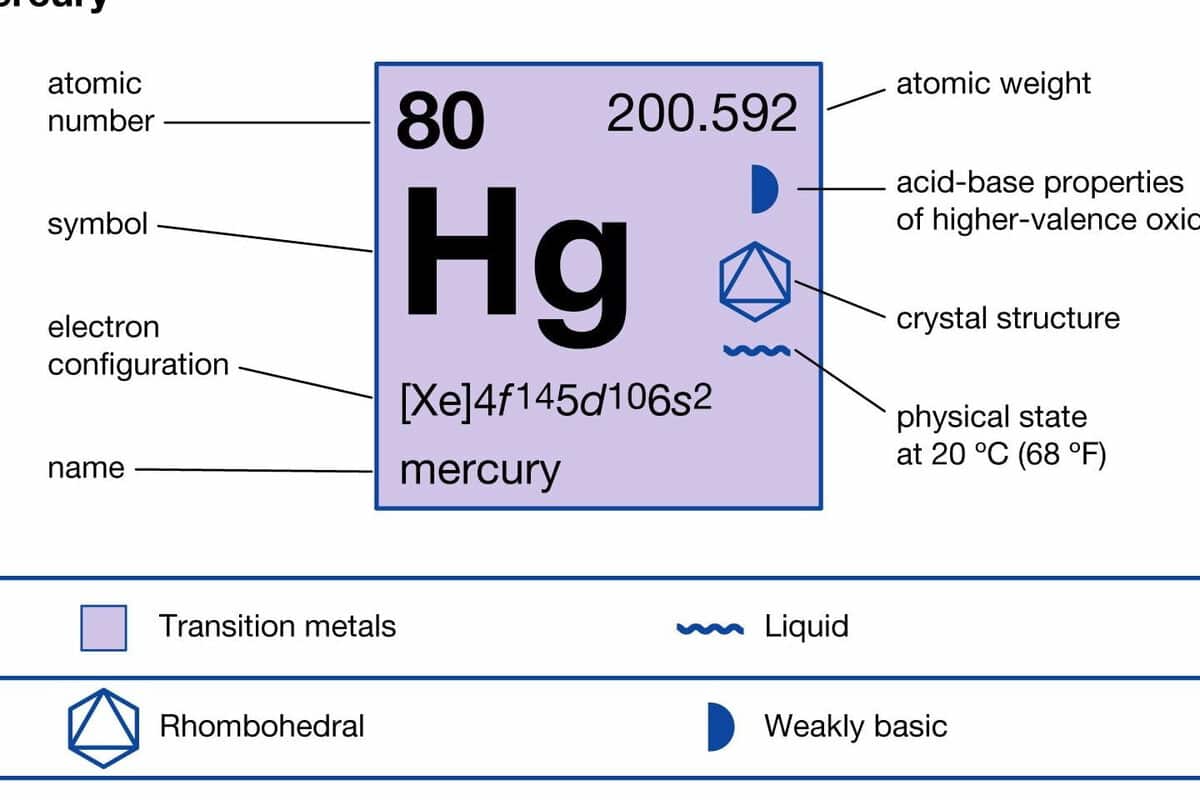A comprehensive guide to the planet Mercury. What is the composition of its surface?
Mercury, which is the smallest planet in our solar system and is located closest to the Sun, is part of the terrestrial planets group. It has a mass that is about 20 times smaller than that of Earth and does not have any natural satellites. Scientists believe that the planet consists of a frozen iron core, which makes up approximately half of its volume. This core is then surrounded by a mantle, and on the surface, there is a silicate shell.
The surface of Mercury bears a striking resemblance to that of the moon, being densely pockmarked with craters, the majority of which were created through impacts with fragments lingering from the formation of the solar system roughly 4 billion years ago. Moreover, the planet’s exterior is adorned with extensive, profound fissures that likely came into existence as a consequence of the gradual cooling and compression of its core.
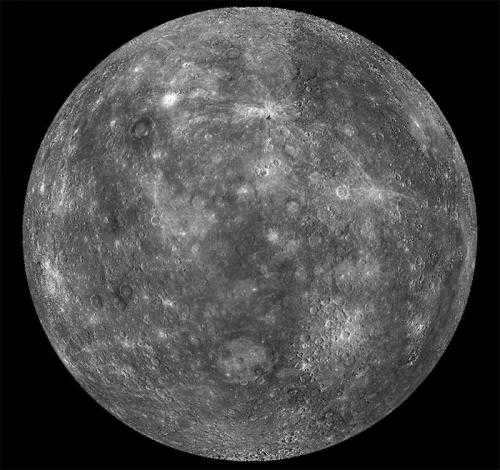
In 2011, the Messenger probe captured an image of the planet Mercury.
Not only do Mercury and the Moon share similar landscapes, but they also have other common features, such as their diameters. The Moon’s diameter is 3476 km, while Mercury’s is 4878 km. A day on Mercury lasts about 58 Earth days, which is exactly 2/3 of a Mercurian year. Another interesting similarity is that, just like the Moon, only the “front side” of Mercury is visible from Earth.
If the Mercurian day is exactly equal to the Mercurian year, it would have the same effect. Before the space age and radar observations, it was believed that the planet took 58 days to complete one rotation around its axis.
Mercury rotates very slowly, but orbits very quickly. On Mercury, a solar day is equivalent to 176 Earth days, meaning that in this time frame, the planet manages to complete two “Mercurian” years due to the combination of its orbital and axial motion.
Moons of Mercury
The MESSENGER spacecraft captured images of the planet Mercury in 2008.
Are there any satellites orbiting Mercury? Learn about the first planet from the Sun, view photos, explore the unique orbital features, discover the history of planet formation and the presence of moons in space, and learn about Hill’s sphere.
It’s interesting to note that almost every planet in our solar system has moons. Jupiter, for example, boasts an impressive total of 67 moons! Even the once-dwarf planet Pluto has five. But what about Mercury, the planet closest to the Sun? How many moons does it have, if any at all?
If satellites are a relatively common occurrence, then why is this planet not fortunate enough to have one? To comprehend the reason, we must grasp the principles of moon formation and examine how it pertains to the situation on Mercury.
The formation of natural moons
Primarily, a satellite can utilize material from the surrounding planetary disk for its formation. Over time, these fragments gradually merge and form larger bodies that can take on a spherical shape. Jupiter, Uranus, Saturn, and Neptune all followed a similar trajectory.
The alternative method involves the ability of massive celestial bodies to exert gravitational force and draw other objects towards them. This phenomenon may be observed in the case of the Martian satellites Phobos and Deimos, as well as the smaller moons orbiting gas and ice giants. In fact, it has been suggested that Neptune’s sizable moon Triton was once considered to be a trans-Neptunian object.

Satellites of the solar system, shown to scale
The final one is a significant collision. When the solar system was formed, planets and other celestial bodies were in search of their positions and frequently collided. These collisions resulted in the expulsion of large amounts of material into space. It is believed that this is how the Earth’s moon formed approximately 4.5 billion years ago.
The Hill Sphere refers to the region surrounding a celestial object that is dominated by the gravitational force of the sun. At the outer edge of this sphere, zero velocity is observed. This represents the boundary that an object cannot cross. In order for an object to acquire a moon, it must be placed within this zone.
Thus, any celestial bodies residing within the Hill sphere succumb to the gravitational pull of the planet. Conversely, if they lie beyond this boundary, they adhere to the gravitational force of our star. This principle also applies to Earth, which retains the Moon within its grasp. However, Mercury lacks any satellites. In fact, it lacks the capability to capture or generate its own moon. Numerous factors contribute to this phenomenon.
Mercury, being the smallest planet in the solar system, unfortunately occupies the first position, rendering its gravitational force insufficient to retain its own satellite. Furthermore, if a sizable object were to enter the Hill’s sphere, it would more likely succumb to the gravitational influence of the sun.
During the 1970s, there was still optimism that a satellite might exist in that particular location. Mariner 10 detected a significant amount of UV radiation, suggesting the presence of a sizable object. However, the radiation vanished the following day. It was later discovered that the instrument had actually detected signals from a faraway star.
Regrettably, Venus and Mercury are left to navigate their paths without any satellites, as they are the only planets in our solar system without companions. Fortunately, we are positioned at an ideal distance and have a substantial Hill sphere. Let us also express gratitude towards the enigmatic object that collided with our planet in the past, giving rise to the Moon!
The atmosphere of Mercury
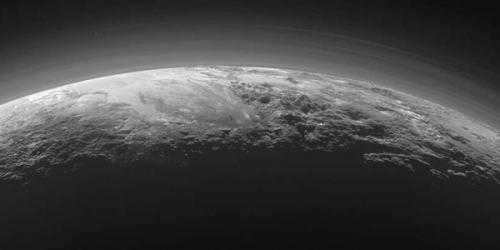
The atmosphere of Mercury is extremely thin, almost non-existent, and its volume is about one quadrillionth of Earth’s dense atmosphere. In addition, the vacuum in Mercury’s atmosphere is much closer to a true vacuum compared to any vacuum created on Earth through technological means.
There are two main reasons for the lack of atmosphere on Mercury. Firstly, the planet’s low density, which is only 38% of Earth’s density, makes it unable to retain a substantial atmosphere. Secondly, the close proximity of Mercury to the Sun makes it highly vulnerable to solar winds, which effectively strip away any remnants of an atmosphere.
However, despite the sparsity of the atmosphere on this particular celestial body, it undeniably exists. As per the esteemed NASA space agency, the chemical makeup of the atmosphere comprises of 42% oxygen (O2), 29% sodium, 22% hydrogen (H2), 6% helium, and 0.5% potassium. The remaining portion consists of a mix of argon, carbon dioxide, water, nitrogen, xenon, krypton, neon, calcium (Ca, Ca+), and magnesium molecules, albeit in smaller quantities.
Temperature of Mercury. Mercury’s Weather
Mercury’s climate: temperature on the first planet, surface dynamics, atmospheric circumstances, polar ice caps, seasonal variations, orbit around the sun.
Starting from the 1950s, a new era of space exploration commenced with the introduction of Earth-based spacecraft that allowed for improved observation and even interplanetary travel.
What kind of weather does Mercury have?
We have gathered a wealth of fascinating knowledge about the planetary cycles within our solar system. Despite its scorching temperatures, Mercury manages to sustain ice reserves in its craters, creating a unique set of weather conditions on the surface of the closest planet to the Sun.
Due to its extreme temperatures and its proximity to the Sun, Mercury lacks a traditional atmosphere. However, it does possess a thin layer of exosphere that contains hydrogen, oxygen, helium, calcium, sodium, water vapor, and potassium. This combination creates a pressure of 10 -14 bar.
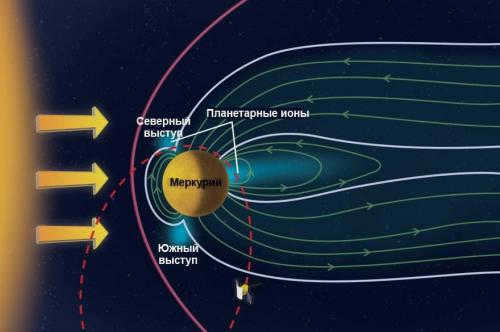
The MESSENGER spacecraft’s spectrometer has detected that Mercury is being bombarded by a powerful solar wind, causing particles on its surface to be blasted into the atmosphere.
The exosphere on Mercury is thought to have formed from particles captured by the Sun, volcanic eruptions, and remnants of meteorites. However, because Mercury lacks a substantial atmosphere, it is unable to retain heat, resulting in sudden temperature fluctuations.
Mercury’s temperature fluctuation is influenced by its highly eccentric orbit, which is the most extreme in the solar system. The planet can approach the Sun at a distance of 46 million kilometers and move away at a distance of 70 million kilometers. As a result, its temperature can rise to 427°C and drop to -173°C.
It takes 58,646 days for the axis to complete one rotation, resulting in three axial rotations for every two orbital rotations.
This signifies that it takes the Sun 176 days to traverse the entire sky. Yes, a single day on Mercury is longer than a year. Moreover, this planet possesses the smallest axial tilt, measuring at 0.027°.
The minimal axial tilt leads to constant shading in the polar regions. Despite the scorching heat, ice reserves and organic molecules remain preserved within the depths of the craters. However, this phenomenon is solely observed at the poles, where the sun’s rays cannot penetrate.
It is believed that the ice reserves at the base of Mercury’s craters can reach 10^14-10^15 kg. It is possible that they are covered by a layer of regolith, which prevents sublimation. Currently, the exact origin of the ice remains unknown. However, comets and water degassing are considered potential sources.
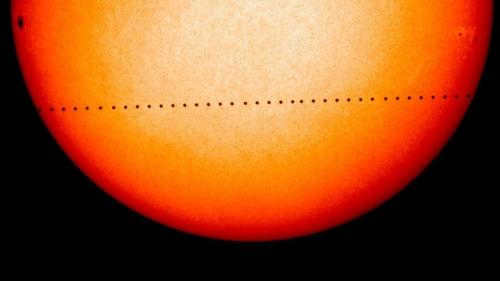
This high-resolution image of Mercury’s transit in front of the Sun was captured by the Solar Observatory.
When discussing the weather on Mercury, it is important to consider the specific moments when the planet’s side is facing the star. During the night half, frost dominates, while the second half is characterized by desert-like and scorching heat. Each season on Mercury spans four years, with two years of midnight Sun and two years of polar night.
These conditions are a result of the distance between Mercury and the Sun, the eccentric orbital path, and the lack of an atmosphere. It is no wonder that no one can live there.
The structure of Mercury – the composition of the first planet in the solar system. Its distance from the Sun, the process of its formation, its density, comparison to Earth, scientific research, and visual representations.
With an average distance of 57.9 million kilometers, Mercury holds the title of being the planet closest to the Sun. It falls into the category of terrestrial planets, known for their rocky composition. However, the question remains: what exactly is Mercury composed of?
What is the Composition of Mercury?
Scientists hypothesize that the composition of Mercury is likely to be akin to that of Earth. It possesses a significant metallic core that exists in a liquid state. Surrounding this core is a layer composed of silica magnesium, followed by a solid crust. It is worth noting, though, that the core of Mercury accounts for as much as 42% of its overall volume, whereas Earth’s core makes up only 17%. Below is an illustration showcasing the structure of Mercury.
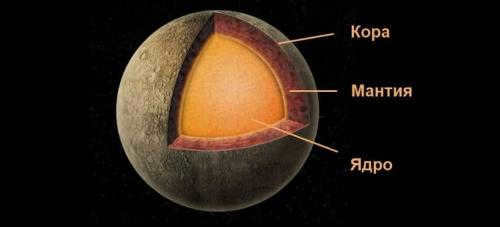
Proposed structure of Mercury
The information indicates that Mercury has a density of 5.427 g/cm 3 , making it the second densest planet in the solar system after Earth. This suggests the presence of a metallic core and a rocky shell. Additionally, it is believed that the iron concentration in Mercury’s core surpasses that of any other planet in our system. In terms of composition, it bears a resemblance to a chondritic meteorite.
The metallic core, which is similar to Earth’s, is the focal point of the planet. However, it encompasses a staggering 42% of the entire planet’s mass, in stark contrast to Earth’s 17%. Curiously, it does not generate a magnetic field of equal intensity. Initially, it was believed that the core was solid, but radio analysis has revealed its liquid state. This was confirmed by observing the rate of oscillation.
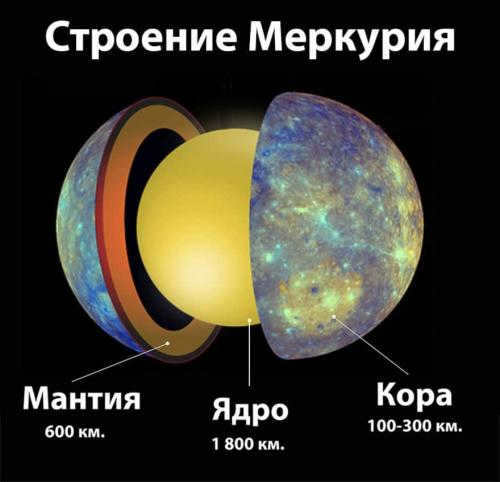
Mercury’s composition by percentage
The mantle, composed of silicates, makes up the majority of Mercury’s composition. It extends 500-700 km from the core. Above the mantle is the crust, which has a thickness of up to 300 km. Studies from Mariner 10 and Earth telescopes have revealed that the surface of Mercury is covered in numerous depressions, which are believed to be a result of frequent and extreme temperature changes.
The surface of Mercury bears a striking resemblance to that of the moon, featuring plains, basins, and craters. The largest crater, Caloris, spans a width of 1,550 kilometers. The impact that created Caloris was so powerful that it triggered volcanic activity on the opposite side of Mercury.
Mercury’s topography: An Overview
Discover the fascinating topography of Mercury, the first planet in our Solar System. Uncover the unique characteristics of its surface, including the nature and abundance of craters, surface temperature variations, and awe-inspiring photographs.
The entirety of Mercury’s surface is adorned with a multitude of crater formations. The lack of an atmosphere on this planet means that there is no protection from the forceful impacts that create these features. However, it is important to remember that Mercury is not the most hospitable planet in our solar neighborhood.
Surface of Mercury
The surface of Mercury can experience extreme temperature conditions, ranging from scorching heat to freezing cold. Despite being close to the Sun, certain areas of the planet are still in the shade and contain reserves of water ice. Additionally, there is a thin layer of exosphere on Mercury that even contains water. Another remarkable characteristic of this planet is its high density, with the core accounting for up to 42% of the total volume of the planet.
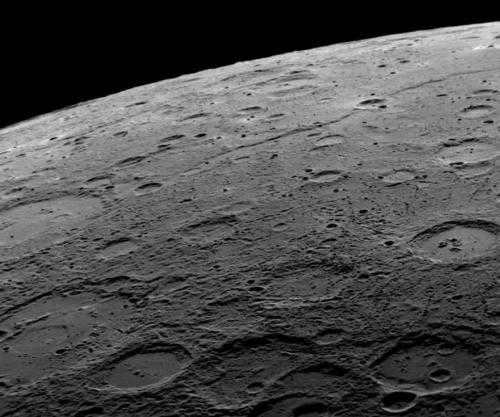
An image captured by the Mariner 10 space probe showcasing the rugged landscape of Mercury.
The surface of this planet has been devoid of any geological activity for billions of years, remaining remarkably stable. Observations through telescopes reveal areas with significantly higher reflectivity, suggesting the presence of various topographical features such as mountain ranges, valleys, plains, and escarpments.
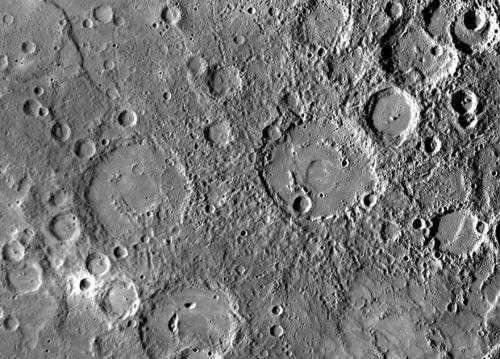
Craters come in various sizes. Some are small receptacles, while others can stretch for hundreds of kilometers. There are also different levels of decay. Some appear very youthful, while others resemble remnants of ancient occurrences.
The largest crater is known as the Caloris Basin (Heat Plain), which measures 1550 kilometers in diameter. The impact triggered the activation of volcanoes on the opposite side and led to the eruption of lava, resulting in the creation of a 2 km high ring on the crater itself.
The entire surface seems to be a mixture. The most impressive images of Mercury taken from space were captured by Mariner-10 and MESSENGER. All in all, it is a rather desolate location.
Planet Venus. Venus: the second planet from the Sun
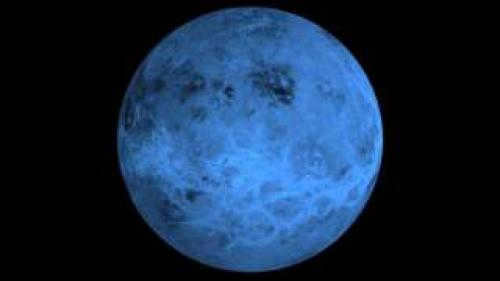
Venus: The Closest Planet to Earth
Venus, the second planet from the Sun, holds the distinction of being the closest planet to Earth. However, prior to the era of space exploration, Venus remained largely mysterious due to its enshrouding clouds, which obscured its surface from view. These clouds consist primarily of sulfuric acid, resulting in a highly reflective composition.
As a result, the surface of Venus remains hidden from sight when observed in visible light. Additionally, the planet’s atmosphere is approximately 100 times denser than Earth’s and is composed predominantly of carbon dioxide.
One can liken the illumination of Venus by the Sun to that of Earth by the Moon on a clear night.
Nonetheless, the planet’s atmosphere is perpetually scorching due to the Sun’s intense heat, causing temperatures to soar to a staggering 500 degrees Celsius. The primary cause of this alarming heating phenomenon is none other than the greenhouse effect, which is brought about by the presence of carbon dioxide in the atmosphere.
Discovery Timeline
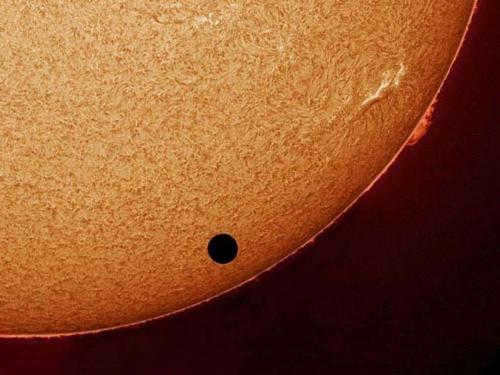
“Venus,” he stated, “possesses a light atmosphere, similar to but not exceeding the atmosphere surrounding our Earth.”
Distinctive Features
- Distance from the Sun: 108,200,000 kilometers
- Length of a day: 117d 0h 0m.
- Mass: 4.867E24 kg (0.815 times the mass of Earth)
- Acceleration due to gravity: 8.87 m/s².
- Orbital period: 225 days
The atmospheric pressure on Venus is equivalent to 92 times the atmospheric pressure on Earth. This means that every square centimeter on Venus is subjected to a gas column weighing 92 kilograms.
The size of Venus is almost the same as Earth’s, with a diameter of 12,104 kilometers, which is only 600 kilometers smaller. Additionally, the gravity on Venus is comparable to that of our planet, as a kilogram weight on Venus would weigh 850 grams. Due to these similarities in size, gravity, and composition, Venus is often referred to as an “Earth-like” planet or “Earth’s sister.”
Unlike other planets in the solar system, Venus rotates on its axis in the opposite direction, from east to west. This behavior is only shared by one other planet, Uranus. A complete rotation on its axis takes 243 Earth days, while a Venusian year lasts only 224.7 Earth days. Interestingly, this means that a day on Venus is longer than a year! Although Venus experiences day and night, it does not go through any changes in seasons.
Discovering
In the present day, scientists are actively investigating the surface of Venus through the use of spacecraft and radio emissions. Their studies have revealed that a significant portion of the planet’s surface is comprised of hilly plains, creating a diverse landscape. The soil on Venus is a vibrant orange color, which contrasts with the sky above. Interestingly, the surface of Venus is covered in numerous craters that were formed by the impact of large meteorites. These craters can reach a diameter of up to 270 kilometers, showcasing the immense force behind their creation. Additionally, researchers have discovered that Venus is home to tens of thousands of volcanoes. Recent studies have even shown that some of these volcanoes are currently active, further adding to the dynamic nature of the planet.
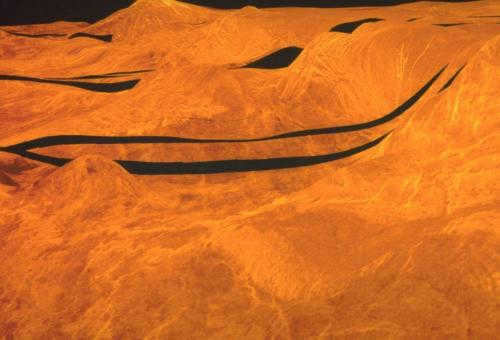
The planet Venus is the third most luminous object in our atmosphere. Venus is referred to as the Morning Star, as well as the Evening Star, due to its brightness being most noticeable just before sunrise and sunset (in ancient times it was believed that the morning and evening Venus were distinct stars). Venus shines brighter than any other stars in the morning and evening sky.
Venus is solitary and lacks any natural companions. It is the sole planet in the solar system to be named after a female deity – the remaining planets are named after male gods.
Is there life on Mercury? Exploring the enigmatic side of the planet
Mercury is a member of the terrestrial group of planets, similar to the other inner planets within the solar system. It holds the distinction of being the smallest celestial body, with a diameter measuring a mere 4879 km. But what exactly is it composed of?
Unveiling the Elements within Mercury
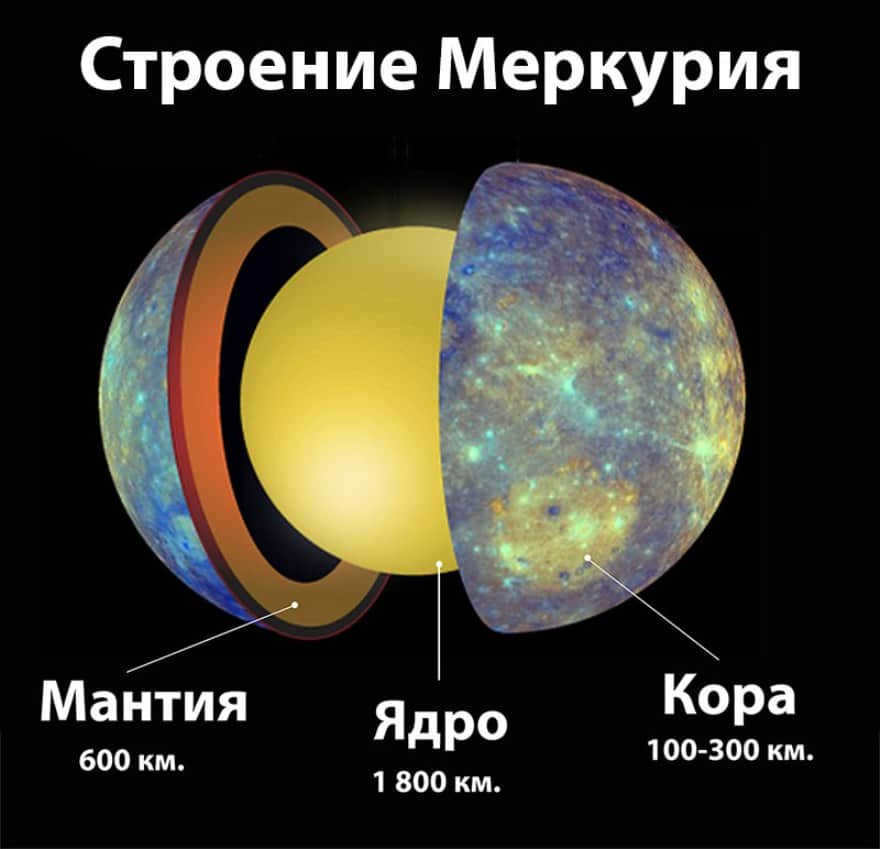
Scientists have discovered that approximately 70% of the planet is comprised of metals, while the remaining portion is made up of silicates. As a result, the density is only slightly lower than that of Earth – 5.43 g/cm3.
In terms of size, Mercury is also smaller than Earth, causing the gravitational force to compress the object so intensely that heavier elements are synthesized within it. Researchers assert that there is a massive iron core that encompasses a staggering 42% of the planet’s volume.
This core extends for a distance of 3,600 kilometers. The mantle accounts for 600 kilometers, with the crust surrounding it measuring 100-200 kilometers. We are aware of the presence of ridges on the planet’s surface that span hundreds of kilometers, which could have been formed as a result of frequent cycles of heating and cooling.
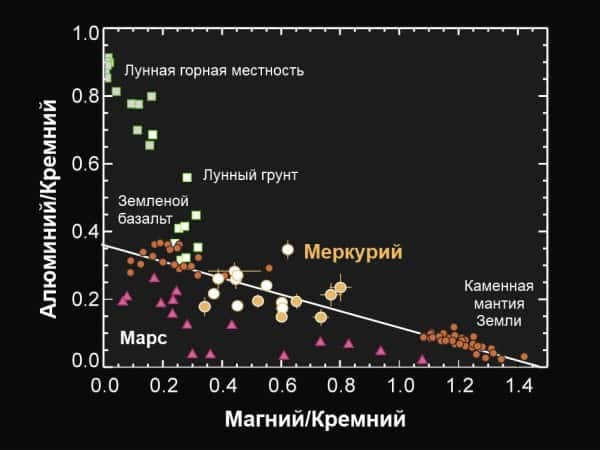
The composition of Mercury is estimated to be as follows:
It is believed that Mercury was once much larger in size, but a collision with a large object caused the outer layers to be stripped away, resulting in its current state. Another theory suggests that Mercury may have formed before the sun’s energy diminished, making it twice as large initially. However, the solar winds gradually eroded the surface layers, leading to its present size. This is how Mercury’s composition can be explained.
Composition of Mercury
Mercury, the planet closest to the Sun with an average distance of 57.9 million kilometers, is classified as a terrestrial planet due to its rocky composition. Scientists have been studying the question of what Mercury is made of, and they believe that its composition is similar to that of Earth.
Mercury is believed to have a large metallic core that is in a liquid state. Surrounding the core is a layer of silica magnesium, and on top of that is a solid crust. It is worth noting that the core of Mercury occupies a significant portion of its volume, accounting for 42% (compared to Earth’s 17%). The diagram below shows the structure of Mercury.
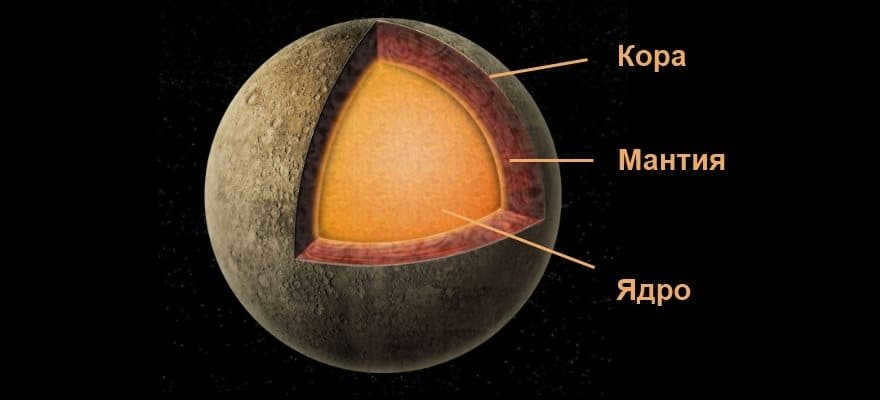
Proposed structure of Mercury
The available data indicates that Mercury has a density of 5.427 g/cm 3 , which places it in the second position in terms of density among all the planets in our solar system, with Earth being the densest. This suggests the presence of a metallic core and a rocky shell. Additionally, it is believed that the concentration of iron in Mercury’s core surpasses that of any other planet in our system. In terms of composition, it even bears resemblance to a chondritic meteorite.
The core of Mercury, similar to that of Earth, occupies the central part of the planet. However, it covers a much larger proportion of the planet, accounting for 42% of its total mass (compared to 17% of Earth’s). Surprisingly, despite its size, the core of Mercury does not generate a magnetic field of the same intensity. It was previously assumed that the core must be solid, but radio analysis has shown that it is actually in a liquid state. This was confirmed through the study of oscillation rates.

Mercury’s composition by proportion
The mantle, composed of silicates, is concentrated around the core and extends 500-700 km. Above the mantle is the crust, which has been observed to have a thickness of up to 300 km by Mariner 10 and Earth telescopes. Numerous depressions are present on the surface, believed to be a result of frequent and drastic temperature fluctuations.
The surface features bear a strong resemblance to those of the moon, displaying plains, basins, and craters. The largest crater, Caloris, has a diameter of 1,550 kilometers. The impact was significant and resulted in volcanic activity on the opposite side.
Composition of Mercury: A Closer Look at Its Chemical Makeup

The Elemental Composition of Mercury
All members of the Earth group of planets, including Mercury, share a similar structure, resulting in comparable chemical compositions. However, Mercury exhibits several unique characteristics.
The planet’s chemical makeup primarily consists of two metals: iron and nickel. Notably, the concentration of iron on Mercury is unusually high. There is a prevailing theory suggesting that this anomaly resulted from a collision between Mercury and a massive celestial body, hundreds of kilometers in radius, during the early stages of the solar system’s formation. Another distinctive feature of Mercury is that its core is in a liquid state.
The earth’s crust is composed of various chemical compounds, including basalts. Basalts contain approximately 42-53% silica, with aluminum oxide making up about 15% of their composition. Ultramafic rocks, which have a high silica content of 30-45%, are also common. Other common rocks found in the crust include kimberlites, ilmenites, and dunites. The overall composition of Mercury is similar to that of the Moon, with a deficit of aluminum, calcium, titanium, and iron, and an excess of magnesium and sulfur.
The atmosphere of Mercury is highly rarefied, containing only a small amount of gases. Among these gases, oxygen makes up 42%, sodium accounts for 29%, and hydrogen comprises 22%. Helium constitutes 6% of the Mercurian atmosphere, while the remaining gases make up less than 0.5%. One might wonder why there is such a significant amount of sodium in the atmosphere, considering that it is not a gas. The explanation lies in the fact that sodium is blown into the atmosphere from the planet’s surface by the solar wind. Due to the scarcity of other gases and the proximity to the Sun, the proportion of sodium in the atmosphere is unusually high.
Furthermore, it is worth mentioning that Mercury also contains water. Water vapor can be found at the bottom of certain craters, where sunlight never reaches, forming ice. However, liquid water does not exist on Mercury.
The Unique Chemical Composition of Planet Mercury
All planets within the Earth group, including Mercury, share a similar structure, resulting in comparable chemical compositions. However, Mercury exhibits a few distinct characteristics.
Mercury’s core is composed of two metals, iron and nickel, with an unusually high concentration of iron. One theory suggests that this anomaly is the result of a collision between Mercury and a massive celestial body hundreds of kilometers in radius during the formation of the solar system. Notably, the core of the planet is in a liquid state.
The primary components of Mercury’s mantle are silicates, which are substances that contain silicon. The mantle is primarily composed of different forms of peridotite, including olivine and pyroxene. Along with silicon, the mantle also has high concentrations of iron, magnesium, manganese, calcium, and oxygen.
On the other hand, the crust of Mercury is made up of basalts and other chemical compounds. Basalt consists of approximately 42-53% silicon oxide (silica), with aluminum oxide making up about 15% of its composition. There is also a significant presence of ultramafic rocks that contain 30-45% silica. Various minerals such as kimberlites, ilmenites, and dunites are widespread throughout the crust. Overall, the composition of Mercury is similar to that of the Moon, with limited amounts of aluminum, calcium, titanium, and iron, but abundant magnesium and sulfur.
Mercury’s atmosphere is extremely thin, resulting in a low concentration of gases. Among these gases, oxygen comprises 42% while sodium accounts for 29% and hydrogen makes up 22%. Helium makes up 6% of Mercury’s atmosphere, with other gases constituting less than 0.5%. The presence of sodium in the atmosphere may seem peculiar since it is not a gas. However, sodium from the planet’s surface is blown around by the solar wind, resulting in its high proportion in the atmosphere due to the scarcity of other gases and Mercury’s proximity to the Sun.
It is worth mentioning that Mercury also contains water. Water vapor can be found at the bottom of certain craters, shielded from the Sun, where ice is present. However, liquid water does not exist on Mercury.
Sources:
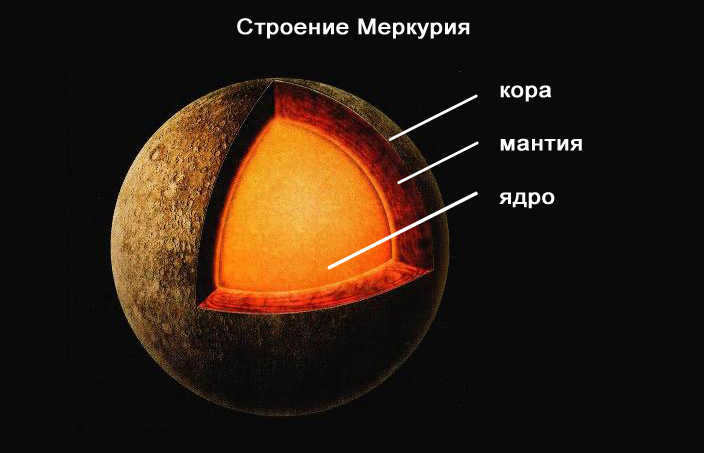
The planet Mercury has been recognized by humans since ancient times. It was first documented in the sixteenth century B.C. in a compilation of Babylonian astrological tables known as the Mul apin. Throughout history, Mercury has been referred to by various names. The Sumerians called it the “jumping planet” in the Mul apin collection, while the Greeks referred to it as Hermaeon and Apollo. The planet acquired its official name from the ancient Romans, who named it after Mercury, the swift god of commerce, due to its faster movement across the sky compared to other planets.
Some basic facts about Mercury
Mercury is the planet that is closest to the Sun. The distance between Mercury and the Sun is approximately 58 million kilometers. Additionally, Mercury holds the title for being the smallest planet in the Earth group. Its radius measures 2440 km, which is smaller than the radii of Saturn’s moon Titan and Jupiter’s moon Ganymede. Despite its small size, Mercury has a significant mass of 3.3*10 23 kg, largely due to its massive core.
In terms of density, Mercury has an average density of 5.43 g/cm 3 , slightly lower than that of Earth. This suggests a higher concentration of metals in its structure, considering the larger size of Earth.
The free-fall acceleration on Mercury is about half of that on Earth, measuring at 3.70 m/s 2 .
Similar to Venus, Mercury does not have any natural satellites.
Appearance of Mercury
Mercury has a variety of unique structural features.
According to scientists, these features were formed as a result of a collision with remnants from the formation of the solar system.
The craters on Mercury vary in shape and size. Some are deep and have multiple rings, while others are smaller depressions. Unlike Earth’s moon, Mercury has fewer large craters. The largest one is the Heat Plain basin, which is 1315 km high and has a diameter of 1550 km. The presence of large craters suggests that there has been no tectonic activity in the crust for the past 4 billion years.
Over time, the craters on Mercury undergo gradual erosion. On well-preserved craters, one can observe rock rays that were displaced during the collision with a celestial object.
On the surface of the planet, there exist regions characterized by a more concentrated arrangement of craters, which are simultaneously older, and regions with a less dense distribution of craters, which are younger and formed due to lava flooding.
Scientists hypothesize that these variations are a result of lava movement.
These two characteristics are contradictory. The presence of plains, or lava fields, suggests past volcanic activity on the planet. However, the quantity and age of craters indicate a prolonged absence of geological activity on Mercury.
- There are numerous jagged ridges that extend for hundreds of kilometers and reach heights of up to two kilometers.
Scientists have not reached a consensus on the origin of ridges. One perspective suggests that these formations are created by crustal bulges resulting from nuclear activity. While on Earth, such bulges are caused by the movement of tectonic plates, on Mercury, the crust is squeezed out due to gradual compression of the core.
Another viewpoint proposes that the ridges may have formed from asteroid impacts.
An intriguing characteristic of Mercury is its predominantly homogeneous surface structure, as revealed by data from the Messenger mission. In contrast, the Moon and Mars, which share similar external features, exhibit distinct left and right hemispheres.
The initial data on the chemical composition of Mercury were acquired in 2011 during the messenger mission. Spectrometry was utilized to examine the upper layers of the surface across a 5 million square meter area. This region exhibited elevated levels of Ca/Si, Mg/Si, and S/Si ratios, while displaying lower concentrations of Al/Si. In simpler terms, the topsoil on Mercury is primarily composed of magnesium, calcium, and sulfur, with minimal amounts of aluminum.
Structure within
The internal makeup of Mercury is characterized by a trilayer composition consisting of a core, mantle, and crust.
Based on data collected by the Messenger spacecraft, the crust measures approximately 26±11 km in thickness.
The mantle, predominantly composed of silicates, has a thickness of 500 km.
The core, which accounts for about 83% of the planet’s total mass, is notably substantial. It exists in a liquid state and is composed of a molten combination of iron and nickel. The iron concentration within the core surpasses that of any other planet.
Mercury’s Atmosphere
The atmosphere of Mercury is incredibly thin. Its pressure is 10^-15 bar, which is 5*10^23 times lower than the pressure on Earth. The composition of the planet’s atmosphere is as follows:
- Oxygen: 42%
- Sodium: 29%
- Hydrogen: 22%
- Helium: 6%
- Potassium: 0.5%
- Other substances: 0.5% (including carbon dioxide, water, calcium, magnesium, nitrogen, xenon, argon, neon, krypton).
The presence of numerous substances can be attributed to the impact of the solar wind, which consists of helium-hydrogen plasma ions. When these particles collide at high speeds, they dislodge sodium, potassium, calcium, and magnesium atoms from the surface, causing them to rise into the atmosphere and loosen the topsoil. Some of these plasma ions escape back into space, while others are captured by Mercury’s magnetosphere. Argon enters the atmosphere as a result of the radioactive decay of potassium, which is caused by the relatively low flux of plasma. Water vapor is generated through the interaction of ground oxides with hydrogen from the solar wind, as well as through the melting of ice in craters.
An individual atom within Mercury’s atmosphere has a lifespan of approximately 200 days. Despite the presence of gravity and a magnetic field, the gases readily disperse into outer space.
The movement of Mercury around the Sun occurs in the shape of a highly elongated ellipse. When the planet is at its farthest point from the Sun, known as aphelion, it is located 70 million kilometers away. On the other hand, during its closest point to the star, called perihelion, it is 46 million kilometers away. This means that during the aphelion phase, Mercury is 1.5 times farther from the Sun compared to the perihelion phase.
Mercury takes 88 Earth days to complete one orbit around the Sun. For a long time, scientists believed that Mercury did not rotate on its axis. However, radar observations in the 1960s revealed that it actually makes 1.5 rotations on its axis for every orbit around the Sun. This unique rotation ratio is not found in any other planet in the solar system. As a result, a day on Mercury lasts for 2 years in Earth time.
Mercury moves around the Sun at a velocity of 48 kilometers per second. The planet rotates on its axis at a constant speed, but its speed of revolution around the Sun varies. During 8 days when Mercury is closest to the Sun (perihelion), its orbital velocity exceeds its axial rotation velocity – 56.6 km/s at perihelion and 38.7 km/s at aphelion. It’s as if the Sun halts and then starts moving in the opposite direction, not westward but eastward. This phenomenon has been named the Joshua effect by astronomers, after a biblical character who predicted the Sun’s stopping.
Unlike Earth, Mercury doesn’t experience seasons. This is because its axis of rotation is tilted at a 90-degree angle to the plane of its orbit. As a result, there are areas near the poles where the Sun’s rays shine horizontally. In these regions, perpetual winter reigns.
Unique Natural Conditions on Mercury
Mercury, unlike any other planet in the solar system, experiences extreme temperature variations. These variations can be attributed to several factors:
- The planet’s slow rotational speed.
- Its close proximity to the Sun.
- A thin atmosphere.
- An eroded surface that poorly conducts heat within the planet.
During the day, the average temperature on Mercury is around 350°C, while at night it drops to -170°C. The highest temperature ever recorded on the planet’s “hot longitude” during perihelion was 427°C, and the lowest temperature reached -183°C.
Mercury contains massive reservoirs of water in the form of ice that are located at the bottoms of craters. This ice remains solid because of the absence of solar heat. Scientists are particularly intrigued by the origin of this ice. The presence of water on the planet suggests the possibility of past or present life.
The Magnetic Field
The magnetic field of Mercury is created by the dynamic effects of molten iron circulating in the planet’s core. Similar to Earth, the magnetic field has a dipole structure with both north and south poles. However, its strength is approximately 100 times weaker than Earth’s magnetic field. Due to the influence of low-plasma wind, the magnetic field is deflected 480 kilometers to the north. Consequently, the south pole is more exposed to cosmic radiation compared to the north pole.
The magnetic field of the planet interacts with the solar wind, creating vortices of low-energy plasma. In 2008, the instruments on the Messenger spacecraft observed vortices that were connected to the planet’s magnetic field. These vortices occur on Mercury at a frequency ten times higher than on Earth.
As a result, the electromagnetic field of the planet contains numerous zones, known as “windows,” with low intensity. These “windows” allow plasma particles from the solar wind to reach the surface of Mercury.
Origin hypotheses
The primary hypothesis regarding the formation of Mercury is the nebular hypothesis. According to this theory, the dwarf planet was created from a cosmic nebula.
There is also a secondary hypothesis. Scientists propose that Mercury was once a satellite of Venus and eventually separated from it, evolving into a planet. Mathematical calculations performed by Tom Van Flander and C.R. Harrington in the 1970s support this theory, as it provides an explanation for the resonant nature of Mercury’s orbit around the Sun, its elongated orbit, and the loss of momentum.
Another theory suggests that Mercury was created from a protoplanetary object, specifically its inner core. This core was constantly bombarded by solar wind and radiation, causing the gradual depletion of lighter chemical elements. This process could explain the relatively low ratio of light elements to heavy elements found in Mercury’s composition.
Continuing the exploration of Mercury
A joint mission between the space agencies of Japan and Europe, the Bepicolombo spacecraft was launched to Mercury in October of this year. The mission will be conducted using two spacecraft in different orbits:
Both spacecraft are equipped with a multitude of exploration instruments provided by various countries involved in the project, including Russia. The Bepicolombo project aims to analyze Mercury’s internal structure and surface composition, study its geological history, investigate the interaction between its magnetic field and solar wind, and map the polar regions to determine the distribution of water ice and hydrogen-containing compounds.
The vehicles are expected to arrive at their destination in December 2025, as predicted by the scientists. This means that within a decade, the scientists will likely confirm or disprove their theories about the source of the planet’s vast ice reserves, craters, rocks, and more.
Mercury is considered the closest planet to the Sun due to its average distance of 57.9 million kilometers. It is classified as a terrestrial planet, known for its rocky composition. However, what exactly is Mercury composed of?
What is the composition of Mercury?
Scientists speculate that when it comes to the makeup of Mercury, we should look to Earth for similarities. It is believed to have a significant liquid metallic core, surrounded by a layer of silica magnesium, and a solid crust. However, it’s important to note that the core of Mercury occupies a whopping 42% of its planetary volume, compared to Earth’s mere 17%. Below is a diagram illustrating the structure of Mercury.

The structure of Mercury is believed to consist of a metallic core and a rocky shell, similar to Earth. The density of Mercury is 5.427 g/cm 3 , making it the second densest planet in our solar system after Earth. The concentration of iron in Mercury’s core is thought to exceed that of any other planet in our system, and its composition is even comparable to a chondritic meteorite.
The metallic core of Mercury covers 42% of the planet’s volume, which is significantly larger than Earth’s core (17% of Earth’s volume). Despite its size, Mercury’s core does not generate a magnetic field of the same intensity as Earth’s. It was previously believed that the core must be solid, but radio analysis has revealed that it is actually in a liquid state, as evidenced by its rate of oscillation.

Mercury’s composition breakdown by percentage
The mantle, composed of silicates, makes up the majority of Mercury’s structure and extends 500-700 km around the core. Above the mantle is the crust, which has been observed to be up to 300 km thick by the Mariner 10 spacecraft and Earth-based telescopes. The surface of Mercury is marked by numerous depressions, believed to be the result of frequent and extreme temperature changes.
The surface of Mercury bears a strong resemblance to that of the moon, with features such as plains, basins, and craters. The largest crater, Caloris, has a diameter of 1,550 kilometers and its impact triggered volcanic activity on the opposite side of the planet.
Composition of Mercury’s Chemical Elements

Chemical composition of Mercury
All planets in the Earth group (including Mercury) have a similar structure, resulting in similar chemical compositions. However, Mercury possesses several unique characteristics.
The core of the planet is comprised of two metals, iron and nickel, with an unusually high concentration of iron. It has been theorized that this anomaly is the result of a collision between Mercury and a massive celestial body with a radius of hundreds of kilometers during the early stages of the solar system’s formation. A distinguishing feature of the planet is that its core is in a liquid state.
The composition of the crust of Mercury is predominantly made up of basalts and various chemical compounds. Basalt, which makes up a significant portion of the crust, contains approximately 42-53% silicon oxide (silica) and 15% aluminum oxide. Ultramafic rocks, which are rich in silica with a content of 30-45%, are also common. Additionally, there are widespread occurrences of kimberlites, ilmenites, and dunites. In terms of composition, Mercury is quite similar to the Moon. However, there is a scarcity of aluminum, calcium, titanium, and iron, while magnesium and sulfur are abundant.
Mercury’s atmosphere is extremely thin, resulting in a scarcity of gases. Among these gases, oxygen comprises 42%, sodium accounts for 29%, and hydrogen makes up 22%. Additionally, helium constitutes 6% of the Mercurian atmosphere, while other gases make up no more than 0.5%. The presence of sodium in the atmosphere may seem unusual since it is not a gas. However, sodium particles originate from the planet’s surface and are “carried” by the solar wind. Due to the lack of other gases and the planet’s proximity to the Sun, the proportion of sodium is significantly elevated.
Furthermore, it is worth mentioning that Mercury also possesses water. Water vapor can be found at the base of certain craters that are perpetually shadowed from the Sun, where ice is present. However, liquid water does not exist on Mercury.
Description and features of Mercury
Mercury is the first planet from the Sun in our Solar System. It is the smallest planet, slightly larger than the Moon and 2.5 times smaller than the Earth.
General information about Mercury
Mercury is a member of the Earth group of planets and does not have any natural satellites. It has a large core made mostly of iron and nickel, which makes up about 3/4 of its diameter. The circulation of molten metal within the core creates the conditions for the formation of a magnetic field. However, this magnetic field is about 100 times weaker than Earth’s.
Mercury completes a full orbit around the Sun in just 88 Earth days, while a day on Mercury lasts for 2 Mercurian years. This ratio is quite unusual compared to other planets in the solar system.
With an average speed of 48 km/s, Mercury moves along an elongated elliptical orbit with a center offset from the Sun.
The surface of Mercury initially appears similar to that of the moon, featuring a mottled appearance caused by numerous craters resulting from comet and meteorite impacts. Additionally, evidence of volcanic activity can be observed, which is indicative of the early stages of the planet’s formation.
Formation Hypotheses
The prevailing hypothesis regarding the origin of Mercury suggests that it emerged from a gravitationally unstable gas-dust cloud following the explosion of a supernova star approximately 4.6 billion years ago. The formation of large gas condensations around the newly formed sun led to the creation of planets, including Mercury.
In the 19th century, an alternative theory emerged proposing that Mercury originally formed as a satellite of Venus before becoming detached. This hypothesis helps to explain the planet’s unique elliptical orbit.
Another theory suggests that during the early stages of the solar system’s formation, there was a sidelong collision between Mercury and Venus. This collision caused Mercury to lose some of its outer layer, including its mantle and crust. Some of these lost materials were absorbed by Venus, while the remaining debris was scattered throughout space.
Another theory suggests that Protomercury collided with a smaller planetesimal, causing it to lose part of its upper layer and resulting in the disproportionate size of its core.
The Composition of the Planet
Mercury consists of a solid core surrounded by a mantle and a crust. Unlike Earth, Mercury’s core is made up of a liquid alloy that remains in a liquid state. The molten core has a radius of 1800 km. On top of the core is a silicate mantle, which is approximately 500 km thick.
The significant eccentricity of Mercury’s orbit, combined with its close proximity to the Sun, generates a strong tidal effect that causes the matter within the core to circulate.
Previously, it was believed that a celestial body of this magnitude could not possess a liquid core. However, radar observations have detected rotational variations that are atypical for planets with a solid core.
The abnormally large size of the core of this celestial body is noteworthy. For comparison, the Earth’s core accounts for only 16% of its total volume, whereas the core of Mercury occupies 70%.
Various data suggests that the solid layer of the planet’s crust has a thickness ranging from 100 to 300 km.
Chemical Composition
The predominant chemical elements that make up the planet consist of iron and nickel. These elements exist in a molten state, filling the planet’s large core. Research has revealed that the proportion of iron in the core’s alloy is greater than that found in other planets within the solar system.
In the upper layer of the planet’s surface, there is a relatively small amount of iron. Instead, calcium, magnesium, and sulfur dominate this region. Aluminum is present in minor quantities.
The composition of Mercury’s surface can be likened to basaltic rocks discovered on Earth, as well as the composition of common meteorites known as chondrites.
Despite having similar elemental content, the average density of Mercury’s upper surface layer is higher compared to that of meteorites.
Based on various photographs, it can be concluded that the surface of the planet bears a striking resemblance to that of the moon, with both being heavily cratered from the impact of smaller celestial bodies. These craters are often surrounded by a halo of ejected matter resulting from meteorite impacts. However, due to the greater gravity on Mercury compared to the Moon, the size of these halos on Mercury’s surface is smaller.
The age of the meteorite impact marks on Mercury varies, with some already being significantly eroded while others have maintained their original shape.
One notable difference between the surface of Mercury and that of the moon is the presence of escarpments, which are rugged ledges along the slopes of mountains. This unique landscape is believed to be a result of the crustal surface undergoing compression during the core’s contraction.
The entire surface of Mercury can be divided into two hemispheres, and it spans a total area of approximately 75 million square kilometers.
Various volcanic activity played a significant role in shaping the landscape of Mercury, as evidenced by the presence of mountain ranges and plains that were once covered in lava.
The Composition of Mercury’s Atmosphere
Mercury’s volatile atmosphere consists primarily of oxygen, sodium, and hydrogen. Unlike Earth, Mercury’s weak gravitational forces are insufficient to maintain a dense atmosphere. Additionally, the planet’s weak magnetic field is unable to retain the atmosphere.
The solar wind carries dust from meteorites, gas particles, and radioactive decay products, resulting in the formation of a thin and impermanent exosphere above Mercury’s surface. This exosphere contains oxygen and hydrogen atoms, as well as helium, sodium, potassium, and some inert gases. None of these elements are bound to the planet, as the pressure from solar radiation causes them to disperse into space.
The scattered atmospheric remnants form a trail of exospheric matter that extends up to 2 million kilometers behind Mercury, resembling the tail of a comet.
Natural conditions
One of the distinctive characteristics of Mercury is its significant temperature contrast.
Due to the absence of a permanent atmosphere, slow rotation, and low density of the upper crust, the planet is unable to retain solar heat effectively. As a result, Mercury experiences a substantial temperature difference between its sunlit and shadowed sides. On the sun-facing side, the surface can reach temperatures as high as +430°C, while at night it can plummet to around -173°C. This daily temperature variation of nearly 600 degrees Celsius is unique to the planet’s surface.
Mercury has a slight tilt in its axis of rotation, which results in the poles being nearly unreachable by the Sun. Radar studies conducted in these areas have indicated the presence of potential ice on the surface. It is believed that this ice is likely covered by a layer of dust and is approximately 2 meters thick.
One hypothesis suggests that these ice deposits were formed as a result of numerous comet impacts. As the water evaporated, it is thought to have traveled across the planet and accumulated in depressions within the rock at the poles, where it subsequently froze. The existence of ice on Mercury raises the possibility of the presence of life on the planet.
Mercury completes one full rotation around its axis (relative to the center of the Sun) in 176 Earth days, which is shorter than its year. This makes Mercury unique in the Solar System. The time it takes for Mercury to complete a revolution around the Sun is half of its own days. The synodic period of Mercury is 116 days.
The shape of Mercury’s orbit is elongated and elliptical, unlike the more circular trajectories of other planets.
Mercury’s average orbital velocity is 48 km/s.
During its passage near perihelion, Mercury moves faster, reaching a speed of 56 km/s. At aphelion, Mercury slows down to 38.7 km/s. The ratio of axial rotation to orbital motion near perihelion creates an unusual phenomenon on Mercury’s surface: the Sun appears to gradually stop and then start moving in the opposite direction.
Magnetic field
The magnetic field of Mercury is generated by the dynamo effect caused by the movement of molten metal in the planet’s liquid core. The same process is responsible for the creation of Earth’s magnetic field, although the magnetosphere of Earth is 100 times more powerful than that of Mercury. On Earth, this magnetic field creates a magnetosphere that can influence the movement of the solar wind, but it is not strong enough to retain a stable and dense atmosphere. In contrast, the magnetic field of Mercury is uneven and contains large areas of low intensity.
Exploration of Mercury
Mercury has been a subject of interest in astronomy since ancient times. It has been mentioned in writings from ancient Babylon, and was described as the morning or evening star in ancient China and ancient Greece.
Despite its significance, studying Mercury has been challenging due to the difficulties in observing it from Earth. However, the space age has provided the necessary tools to explore this planet.
Recent advancements in the study of Mercury include:
- In 1974, the American interplanetary automated station Mariner-10 made the first close flyby of Mercury, coming within 320 kilometers of the planet. This mission captured numerous photographs of Mercury’s surface and led to the suspicion of the presence of ice.
- In 2004, NASA initiated the launch of the Messenger research vehicle, which successfully arrived at Mercury in 2008 and subsequently entered its orbit in 2011. This artificial satellite conducted a comprehensive study of Mercury’s atmosphere, surface, and landscape, while also analyzing the elemental composition of the planet and its exosphere. Notably, it was during this mission that the first detailed map of Mercury’s surface was meticulously created. Unfortunately, in 2015, the probe tragically descended onto the planet.
- Fast forward to 2018, the BepiColombo mission was launched, representing a collaborative effort between European and Japanese research modules. The primary objective of this mission is to reach Mercury by the year 2025 and meticulously investigate its atmosphere and magnetic field.
Looking ahead, Roscosmos has ambitious plans to send a vehicle to Mercury’s surface, ultimately aiming to achieve the first-ever landing on this celestial body. With preparations already underway, the launch for this groundbreaking mission is scheduled for the year 2030.
Chemical makeup of Mercury
All planets within the Earth group, including Mercury, share a similar structure, resulting in comparable chemical compositions. However, Mercury possesses a few distinct characteristics.
The planet’s composition is primarily composed of two metals, iron and nickel, with an unusually high concentration of iron. It is theorized that this anomaly is a result of a collision between Mercury and a massive celestial body, hundreds of kilometers in radius, during the early formation of the solar system. Notably, Mercury’s core is in a liquid state.
The dominant substances in the mantle of Mercury are silicates, which are composed of silicon. The main forms of silicates found in the mantle are peridotite, including olivine and pyroxene. Along with silicon, the mantle also contains high concentrations of iron, magnesium, manganese, calcium, and oxygen.
The crust of Mercury is made up of basalts and various other chemical compounds. Basalt, for example, contains approximately 42-53% silicon oxide (silica), with aluminum oxide accounting for an additional 15%. Ultrabasic rocks, which contain a high percentage of silica (30-45%), are also prevalent. Other common rocks on Mercury include kimberlites, ilmenites, and dunites. Overall, Mercury’s composition is similar to that of the Moon. However, there is a shortage of aluminum, calcium, titanium, and iron, while magnesium and sulfur are abundant.
It is important to mention that Mercury also contains water. There is water vapor present in the depths of certain craters, which are never exposed to the Sun, where ice can be found. However, there is no liquid water on Mercury.
Here is a list of sources that were used:
Mercury – the planet closest to the Sun (general information about Mercury and other planets in our solar system – the average distance from the Sun is 57,909,176 km. However, the distance from the Sun to Mercury can vary from 46.08 to 68.86 million km.
The distance between Mercury and Earth ranges from 82 to 217 million km. Mercury’s axis is almost perpendicular to the plane of its orbit.
Satellites
Mercury does not have any satellites.
Key features of the planet Mercury
Average orbital velocity, km/s
Equatorial radius (compared to Earth)
Equatorial radius, km
Rotation period around its axis, days
Rotation period around the Sun, days
Inclination of the equator to the orbit, degrees
Surface temperature, °C
Mass and Dimensions
Mercury is a relatively small planet, with a mass that is only one-twentieth of the Earth’s mass. Additionally, its radius is 2.5 times smaller than that of the Earth.
Scientists hypothesize that at the core of the planet lies a large iron core, which makes up approximately 80% of the planet’s total mass. Above this core, there is a mantle composed of rocky rocks.
The surface of Mercury resembles a shrunken apple peel, characterized by numerous cracks, hollows, and mountain ranges. The highest peaks of these mountain ranges can reach heights of 2-4 km. The average density of the planet’s crust is estimated to be 5.43 g/cm3.
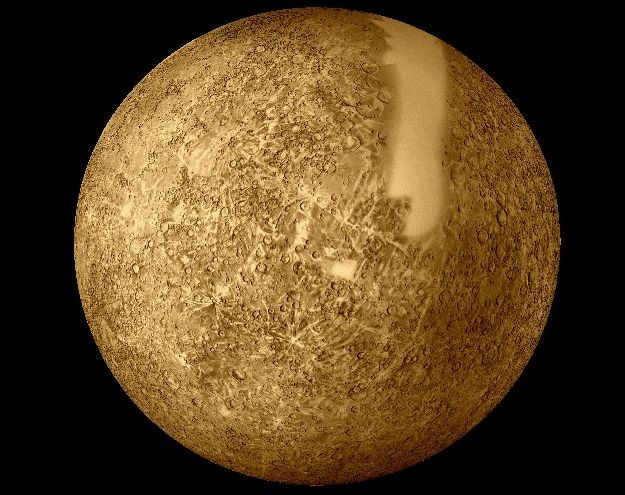
Composition of Mercury’s Atmosphere
Mercury has an incredibly sparse atmosphere composed of hydrogen, helium, oxygen, and traces of calcium, sodium, and potassium. The planet most likely acquires its hydrogen and helium from the Sun, while the metals are vaporized from its surface. However, the term “atmosphere” is a bit of a stretch for this thin shell. The atmospheric pressure on Mercury’s surface is approximately 500 billion times less than that of the Earth’s surface, which is even lower than the pressure in today’s vacuum facilities on Earth.
Temperature
Mercury’s surface sensors have recorded a maximum temperature of +410 °C.
The night hemisphere has an average temperature of -162 °C, while the day hemisphere has an average temperature of +347 °C, which is hot enough to melt lead or tin.
Temperature variations on the day side can reach 100 °C due to seasonal changes caused by the elongation of the orbit. However, at a depth of 1 meter, the temperature remains constant at +75 °C because the porous soil does not conduct heat well.
Mercury’s rotation axis has an insignificant inclination to the plane of its orbit, resulting in no noticeable seasonal changes on the planet.
- Exploring new territories
- Creating maps and blueprints
- Using symbols and icons on geographic maps
- There are three types of map scales: numerical, named, and linear.
- Geographic maps can be classified into various types.
- Geographic coordinates are used to determine specific locations on Earth.
- The solar system consists of the following planets:
- Mercury
- Venus
- Mars
- Jupiter
- Saturn
- Uranus
- Neptune
- Rocks and minerals are important components of the Earth’s crust.
- The composition and structure of the atmosphere play a crucial role in Earth’s climate.
- Air temperature changes occur on Earth due to various factors.
- Solar radiation affects the Earth’s climate.
- Atmospheric pressure is an important parameter in weather forecasting.
- Wind speed, strength, and direction are key elements of weather patterns.
- Atmospheric circulation is responsible for the movement of air masses.
- Atmospheric precipitation includes rain, snow, and other forms of moisture.
- The climate on Earth varies in different regions.
- Symbols are used to represent different weather conditions.
- Earth’s climate has been changing over time.
- Weather refers to the atmospheric conditions at a specific place and time.
- The hydrosphere encompasses all the water on Earth.
- The world ocean level is an important indicator of global sea levels.

